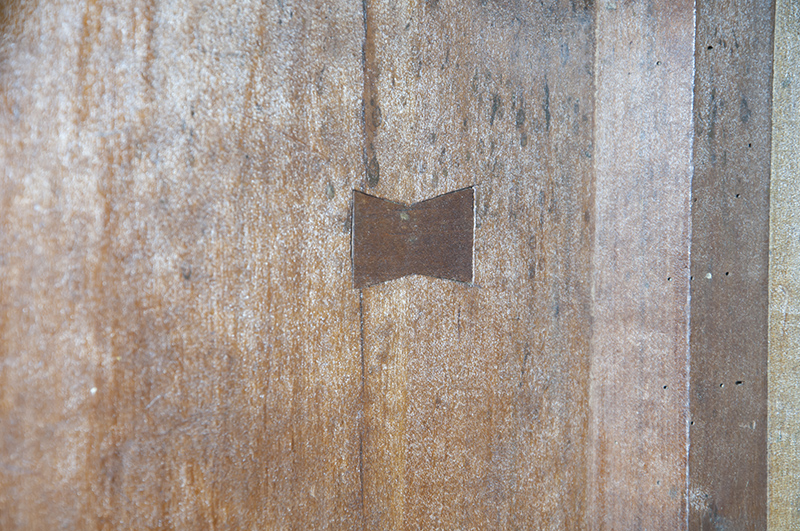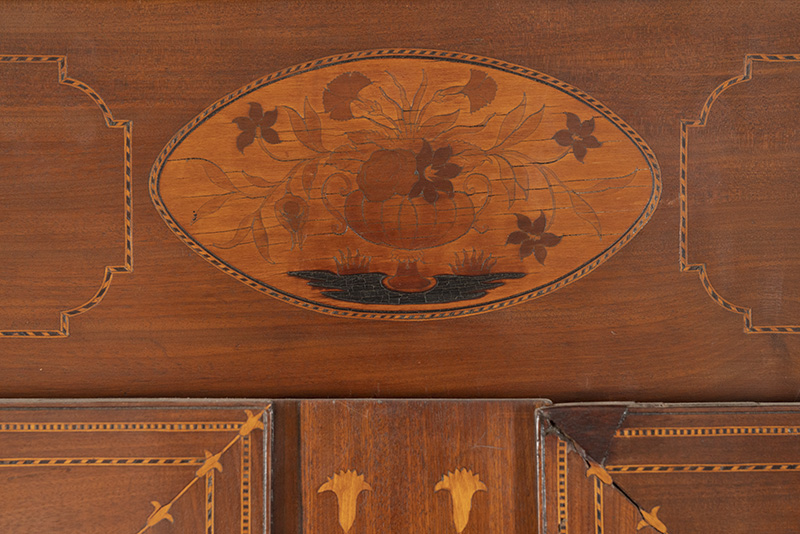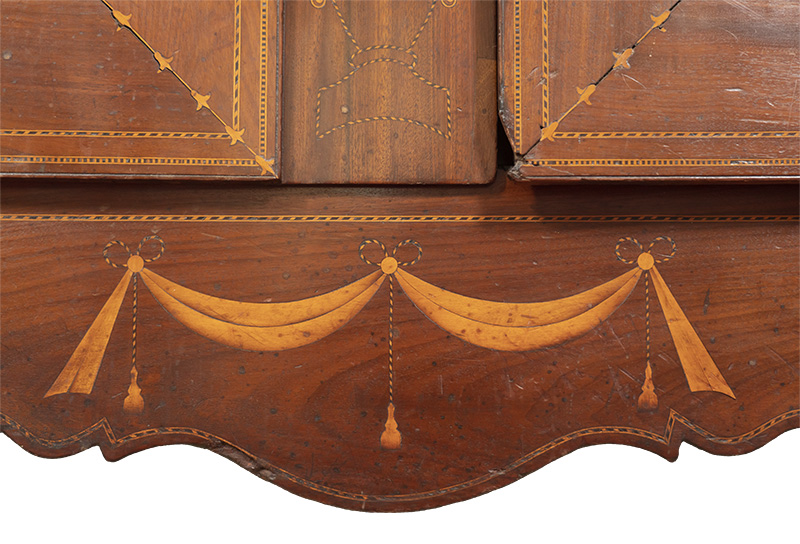A Material Culture Mystery: Cybèle Gontar on ‘Chasing the Butterfly Man’
by Taryn Clary
Who was the Butterfly Man? The anonymous cabinetmaker worked in New Orleans, LA, in the first quarter of the 19th century, a moment of great change and population growth following the Louisiana Purchase in 1803. His distinctive series of armoires reflected the diversity of furniture styles arriving and developing in the French Quarter, uniting construction techniques of the French West Indies with Anglo-American Neoclassical motifs. His work is represented by 18 extant armoires, many of which are in private hands and all of which bear the same compelling clue: a “butterfly” or double dovetail patch applied to reinforce the side wall panels.
Art historian and curator Cybèle Gontar took on the challenge of solving this fascinating material culture mystery, and in December 2019 published her findings in Chasing the Butterfly Man: The Search for a Lost New Orleans Cabinetmaker, 1810-1825. Gontar, a native of New Orleans and a widely published author on 18th- and 19th-century American art, proved to be the perfect detective for the case. Her publication takes the reader through a technical analysis of the Butterfly Man’s designs and not only compares his work to other identified craftsmen of the period, but also contextualizes it within a larger cross cultural history of cabinetmaking. The accompanying exhibition at The Cabildo, a Louisiana State Museum site in New Orleans (on view through March 7, 2021), brings this research to life and offers a rare opportunity to see eight of the armoires side by side.
Though the chase may not have led to a definitive conclusion, Chasing the Butterfly Man is a riveting exploration of the 19th-century furniture trade and the role cabinetmakers played in society. Gontar spoke with the Decorative Arts Trust to shed light on what informed her investigation into this enigmatic figure, his trademark craftsmanship, and the significance of his contributions to the artistic culture of Louisiana.
Decorative Arts Trust: What first spurred your in-depth investigation into the identity of the Butterfly Man?
Cybèle Gontar: Fifteen years ago, I was very involved in research for the regional furniture study Furnishing Louisiana: Creole and Acadian Furniture, 1735-1835 (Historic New Orleans Collection, 2010). Several Butterfly Man armoires were documented for that project and a couple of them had suffered Hurricane Katrina. The silver lining was that I had a chance to closely examine two of the armoires taken apart in the restorer’s shop. This gave detail to the descriptions in the book and an article in The Magazine Antiques. Though Furnishing Louisiana did not allow for much construction study, it was something that needed to be done, and the question of the maker’s identity required consideration. Ultimately, with Butterfly Man we found more of his cabinets, realized more of his construction methods, and came a lot closer to identifying him, though it is a mystery not likely to be fully solved. You have to read the book to find out about that.
DAT: You have a strong background in both American art history and European decorative arts, including an M.A. from Parsons School of Design and Cooper Hewitt, Smithsonian Design Museum as well as experience in the European Sculpture and Decorative Arts Department at the Metropolitan Museum of Art. Did you always know you wanted to return to the art and furniture of New Orleans and Louisiana?
CG: From my early days interning with decorative arts curator John Keefe at the New Orleans Museum of Art, my historical research has been nearly singularly devoted to Louisiana—in material culture and fine art. After my PhD coursework and orals were complete at the Graduate Center, City University of New York, I relocated to Washington, DC, for a Pre-doctoral Fellowship at the Smithsonian National Design Museum to finish my dissertation about two early New Orleans portrait painters. Because my work constantly took me to New Orleans, it was sensible to return there and bring various projects to fruition. My years at the Metropolitan Museum were formative in terms of museum culture, exhibition preparation and access to libraries, but the marrow of my work remains the questions that inspire me here. No other place has so captured my imagination, and I feel very fortunate to have such compelling material to consider.
DAT: Could you share insight into your research methods? What kinds of written records and archives were you able to draw from to complement close visual analysis of the cabinets?
CG: Primary sources are paramount. During the research for Furnishing Louisiana, we compiled exhaustive lists of every cabinetmaker recorded from 1718 to 1835, yet I have still found more recently. To try to identify the Butterfly Man, I winnowed the original list down to only those working between 1810 and 1825. That list was further refined to include only those who had some longevity in terms of their career in New Orleans, and also those who had apprentices. I did not include cabinetmakers who were only included in a directory for a single year, as it didn’t make much sense. The Butterfly Man’s armoires indicate a fairly large and sophisticated operation. Working with those names, I cross checked every one in the archival probate records at the New Orleans Civil District Court. In this way, I found folders stuffed with furniture invoices for Thomas Willard, Auguste Douce, and others. Going to lectures and conferences is also important. Attending the Winterthur Furniture Forum and hearing Steven Latta speak about inlay brought our attention to the work of George Dewhurst. When Latta said that Dewhurst had lived in New Orleans where he died in 1822, Dr. Jack Holden, a coauthor for Furnishing Louisiana, and I almost fell out of our chairs. What a discovery! Latta graciously contributed his research to the Butterfly Man catalogue. I have made all kinds of interesting discoveries at Winterthur, the Frick Library, The Met, New Orleans Public Library, etc. but reading up, visiting museum collections, and going to talks is key.
DAT: Do you have a favorite example of the Butterfly Man’s work? What construction and design details are signature to his style in addition to the double dovetail patch?
CG: My favorite ones are those inlaid with cyphers to personalize them, probably celebrating a marriage and the establishment of a household. Cabinetmakers looked at engraving books for those patterns just like silversmiths did. It is captivating, the thought of something like that being delivered and newly filled with linens and the delight and pride that it would have brought to a household. Every object has its time and place, and as a historian you try to explore that as much as possible. The armoire’s architectural quality and grandeur evoke Greco-Roman temple forms. One armoire bears the initials “SR,” perhaps for Sosthène Roman, and his name reminds us how much the Classical world appealed. Otherwise, the inlaid Neoclassical patterns decorating these essentially French cabinets reflect a newly American Louisiana, as any material culture sleuth may deduce.
Butterfly Man armoires include cypress panels in the top and bottom, quite specific apron patterns, and a rear rail support that spans the case width. Those details and numerous others are described and illustrated in the book.
DAT: Your investigation includes important documentation of how Haitian émigrés, refugees, and enslaved and free people of color established themselves as cabinetmakers and craftsmen in the French Quarter. How did the social and political context of the region inform your understanding of the Butterfly Man’s work?
On pages 125-129 of the Butterfly Man catalogue I include all of the cabinetmakers listed in the city directories between 1805 and 1824. There are so many interesting names such as Baltazare Demazilière, Quessaire Dessource, and my favorite, Pringi Parigo. Most of those men were French, and a good number were free men of color. Of the 23 men who qualified as candidates for the Butterfly Man, nearly half are identified as free men of color—one, Silvain Mamja, we only discovered as a free man of color after the catalogue was published. Of those individuals, some were considered master cabinetmakers, who trained indentured apprentices. Often the indenture contracts show that these young persons were from San Domingue. The social and cultural impact of the arrival of Haitian émigrés, both free and enslaved, on New Orleans cannot be underestimated; to this day the city remains under the sway of that cultural amalgamation in terms of our music, cuisine, and design. The Butterfly Man armoires were made with mahogany from the French West Indies, and almost certainly by the hands of some individuals who came from there. This does not preclude the involvement of an Anglo-American maker, and it was important to show the diversity of persons who worked in that trade during those decades. I asked our book designer to extract the signatures of all of the cabinetmakers from the indenture contracts. Sometimes those inscriptions, rather poignantly, are our only reminder of these craftsmen. Which one was the Butterfly Man? His work may be broadly characterized as Franco-American, but I would say that the simplicity, the restrained elegance of these cabinets, is a West Indian quality. I visited the Stephen Girard College collection in Philadelphia, and Girard’s armoire made by San Domingue cabinetmakers (p. 55) is quite the same.
DAT: The book accompanies an exhibition at The Cabildo, a Louisiana State Museum site in New Orleans, which brings together eight of the eighteen identified Butterfly Man armoires. What was it like to see these pieces, most of which are in private collections, united on display for the first time?
CG: Moving, transporting, and lifting ten armoires up the stairs of the Cabildo was a huge task. It took a large team of strong people and careful logistics. Lots of details were thoughtfully considered, especially how to carry them, so that the delicate legs would not snap. We had special plinths built for the cabinets, each specifically measured and cut for each armoire. Additionally, we had pieces repaired and restored for the exhibition. Indeed, it is a wonderful moment to see these cabinets together in the same space to tell the story of this unknown cabinetmaker. It is a once in a lifetime experience to bring together objects from the same workshop heretofore unknown to the public. I regard such an exhibition and publication as an act of preservation. This kind of documentation and study results in greater appreciation for these artifacts.
DAT: Do you consider the case of the Butterfly Man closed, or will you always keep an eye out for more clues?
CG: Descendants of some of the cabinetmakers, such as Etienne Bertel, have turned up for tours and book events, which is such a treat. I talk with the audience about all the possibilities and how we arrived at our conclusions. I especially like the open-ended part of this story, which is what drew me in to begin with. It allows our audience to follow the path of exploration, and in doing so, absorb this fascinating history in a very engaging way. As I enter a phase of my career where I am mentoring new scholars, I hope for them to encounter such questions.
DAT: What projects are you currently developing, either on decorative arts or your program at the Degas Gallery?
CG: The American Campeche Chair is coming soon! In 2021, A Century on Harmony Street: The Kohlmaier Cabinetmakers of New Orleans will be on view, accompanied by an exhibition catalogue. It is a similarly local story of a German-born cabinetmaker Ruppert Kohlmaier, a prolific talent whose extraordinary furniture graces many New Orleans homes. He began his career here at Feldman’s Antique Emporium on Royal Street, until he opened his own workshop on Harmony Street in the late 1920s. His son, Ruppert, Jr. is now eighty-five years old and still there every day. During this time of Covid restrictions, my gallery has been often closed, and I have spent many afternoons with him among all the woodworking tools and furniture recording his recollections with my iPhone.
In my other life as a gallery owner, I exhibit the work of mainly local artists. This spring we are showing two artists whose work is botanical, and in early summer we are planning an ode to the Norwegian painter Edvard Munch, and a furniture and landscape show.
The Butterfly Man exhibition is on view at the Cabildo in New Orleans through March 9. If you are unable to see the show, make sure to take the virtual video tour with Cybèle.
Read more about antiques and the decorative arts field by browsing the Decorative Arts Trust blog, by signing up for the e-newsletter, and by following the Trust on Facebook and Instagram. The Decorative Arts Trust appreciates the support of members and donors to share stories like this one with interested readers.
About The Decorative Arts Trust Bulletin
Formerly known as the "blog,” the Bulletin features new research and scholarship, travelogues, book reviews, and museum and gallery exhibitions. The Bulletin complements The Magazine of the Decorative Arts Trust, our biannual members publication.















